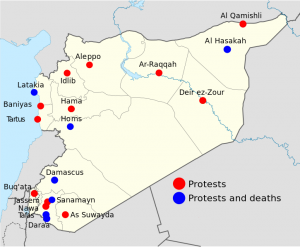 The crisis in Syria continues to deteriorate. Recently, the U.N. reported that more than 5,000 people have died in Syria. Yesterday, Human Rights Watch published a report providing firm documentation that the very highest levels of Syria’s
The crisis in Syria continues to deteriorate. Recently, the U.N. reported that more than 5,000 people have died in Syria. Yesterday, Human Rights Watch published a report providing firm documentation that the very highest levels of Syria’s government regime gave security forces “shoot to kill” orders. And today, security forces are “clashing” with protestors in Homs despite the regime’s promises to halt the violence pursuant to the Arab League peace proposal.
As I wrote several months ago, the Security Council is unlikely to do anything substantial on Syria. The West’s bait and switch on Libya left Russia and China feeling like they got played. As a result, Russia and China have been loath to agree to anything beyond mere condemnation out of the concern that any Security Council resolution could somehow provide legal authority for military intervention.
Interestingly, Russia introduced a Security Council resolution on Syria yesterday. As Colum Lynch of Foreign Policy writes, the resolution is “watered-down”. While the resolution condemns the Syrian regime for the “disproportionate use of force”, it also seeks to contextualize the crisis in Syria as two – sided. For instance, it condemns the activities of “extremist groups” for attacking state institutions and law enforcement personnel.
While defectors from Syria’s army have reportedly engaged in attacks on security forces loyal to Assad, dissident forces have not attacked civilians to my knowledge. Moreover, the opposition hasn’t sprung up in a vacuum – they organized because the Syrian government has killed and abused thousands of civilians. Indeed, the Assad regime has been speaking out of both sides of its mouth. It claims to have responded positively to the Arab League’s peace proposal while continuing to use deadly force against protestors in Homs just today. While the Security Council may have an interest in halting all violence, any resolution coming from the Council needs to be clear about who is most responsible for Syria’s violence and atrocities – Syria’s regime.
So, why is Russia putting a resolution forward on Syria? Perhaps, they are feeling the heat from the international community. It’s been nine months; the Arab League is fed up. Civil society groups keep coming out with reports documenting the Syrian regime’s atrocities, and Assad’s interview with Barbara Walters was frankly ridiculous. It simply confirmed what many suspect – Assad is not serious about resolving the crisis peacefully. Another factor might be Russia’s domestic electoral crisis. Maybe the Kremlin is hoping to deflect attention from its own domestic problems.
A final reason, which I suspect is the dominant factor; Syria’s crisis is getting way out of hand. It’s gone from a domestic problem to a human rights crisis to a country on the brink of civil war. Wars in this part of the world have a tendency to pull in regional players. Some analysts believe Turkey may intervene to provide a safe haven in northern Syria, a suspicion recently denied by Turkish Prime Minister Erdogan. By putting forward a resolution, albeit weak, Russia can look like it is doing something on Syria, even if it’s toothless. Such a move enables Russia to downplay or discredit arguments that it is stonewalling action at the Security Council.
So, what should the Security Council be doing? Given that the regime continues to attack protestors while claiming to implement the Arab League’s recent proposal – of which a major condition is halting violence – any strategy for protecting civilians has to include the threat of coercive measures. For numerous reasons, military action is not desirable. It could draw Iran into the crisis; international military resources are stretched thin; it’s difficult to protect civilians from the air; and it would likely draw the international community into another expensive nation building enterprise. An orderly exit from power by Assad and a peaceful transition to representative governance would be ideal. But let’s face it – that is unlikely.
So, if the international community is serious about protecting civilians from violence and promoting democratic governance in Syria, it needs to use a “carrot and stick” approach. While undesirable, the credible threat of coercive action has to remain on the table. Otherwise, the Assad regime will continue to use deadly force to suppress the opposition knowing that there will be no punitive consequences for attacking civilians.
A recent report by the International Crisis Group characterizes the threat of military action as “naïve, counterproductive and irresponsible.” It’s hard to believe that is true if the threat of force were credible. It’s certainly not right now because there seems to be little appetite for intervention by the West, and Russia and China are firmly against military action.
Again, it’s not the desired option. Supporting the Arab League’s efforts to pressure Assad to halt the violence and engage in a political process with the opposition seems to be the best strategy for protecting civilians, averting a full – scale civil war and resolving the crisis. But, as the death toll rises, and the Syrian regime continues to kill and balk on its promises, one has to ask – how much longer should the world wait before intervening?